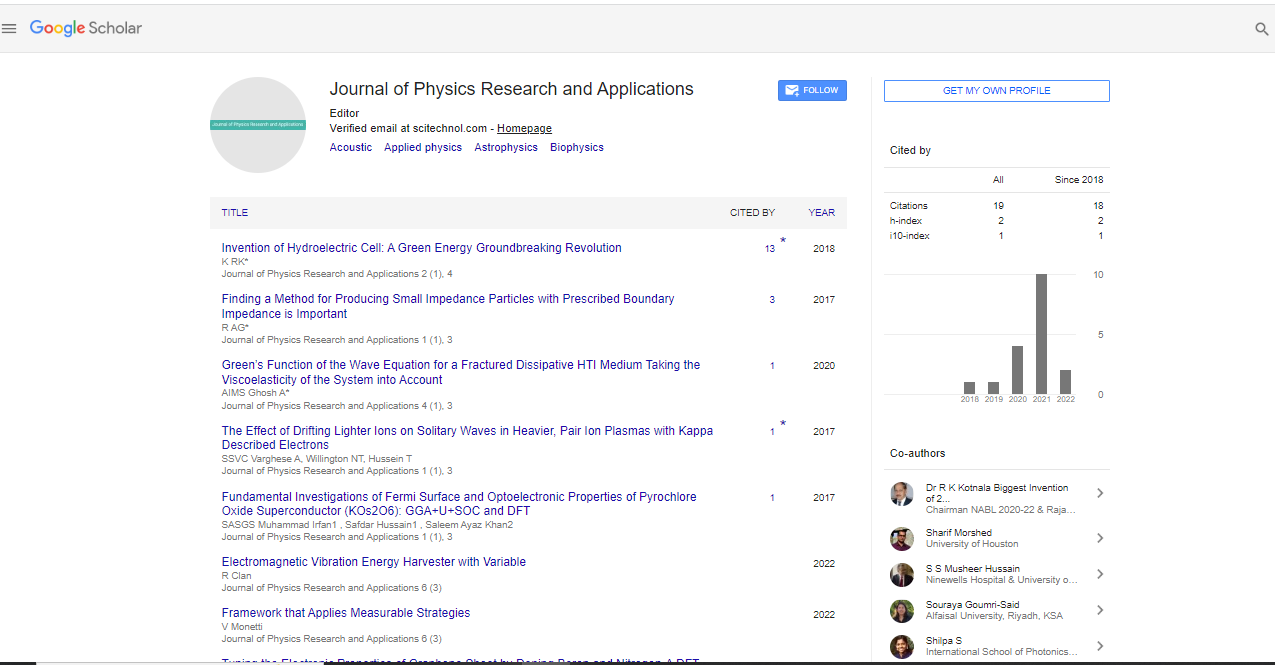Commentary, J Phys Res Appl Vol: 8 Issue: 3
Methods and Technologies for Detecting Gravitational Waves
Lauriat Kristine*
1Department of Physics, Duke University, Durham, USA
*Corresponding Author: Lauriat Kristine,
Department of Physics, Duke University,
Durham, USA
E-mail: Kristi@lara.edu
Received: 26 August, 2024, Manuscript No. JPRA-24-151990;
Editor assigned: 28 August, 2024, PreQC No. JPRA-24-151990 (PQ);
Reviewed: 11 September, 2024, QC No. JPRA-24-151990;
Revised: 18 September, 2024, Manuscript No. JPRA-24-151990 (R);
Published: 25 September, 2024, DOI: 10.4172/JPRA.1000114.
Citation: Kristine L (2024) Methods and Technologies for Detecting Gravitational Waves. J Phys Res Appl 8:3.
Description
Gravitational waves, ripples in the space. These are predicted by Albert Einstein in 1916 as part of his general theory of relativity; these waves were first directly detected by the Laser Interferometer Gravitational-Wave Observatory (LIGO) in 2015. The primary method for detecting gravitational waves is laser interferometry, a technique that utilizes the principles of interference to measure extremely small changes in distance. At the heart of this technology are large-scale interferometers, which consist of two long, perpendicular arms typically several kilometers in length. In LIGO, for example, each arm measures 4 kilometers, while the virgo detector in Italy features arms that are 3 kilometers long.
In a laser interferometer, a laser beam is split into two separate beams that travel down each arm. When a gravitational wave passes through the interferometer, it stretches space in one direction while compressing it in the perpendicular direction. This distortion alters the lengths of the two arms, causing the beams to take different amounts of time to return to the beam splitter. When the beams are recombined, they create an interference pattern, which shifts based on the relative lengths of the arms. By analyzing these shifts, scientists can detect the presence of a gravitational wave and gather information about its source. LIGO, with its two detectors are located in Hanford, Washington and Livingston. Louisiana has been instrumental in the field of gravitational wave astronomy. The detectors are designed to be highly sensitive, capable of measuring changes in length on the order of one-tenth the diameter of a proton. This level of precision is necessary because gravitational waves are incredibly faint, often distorted by noise from environmental factors such as seismic activity, thermal fluctuations and even human activity.
Virgo, situated near Pisa, Italy, complements LIGO's efforts with its own capabilities and adds a crucial European dimension to gravitational wave detection. The collaboration between LIGO and Virgo has significantly improved the localization of gravitational wave sources and enhanced the overall detection efficiency. Together, they have confirmed the existence of multiple gravitational wave events, including mergers of black holes and neutron stars, providing profound insights into these cosmic phenomena.
To enhance sensitivity and reduce noise, both LIGO and Virgo have implemented several advanced techniques. Quantum mechanics ststes that light has inherent noise that can limit measurement precision. By manipulating the quantum state of light, scientists can reduce noise in certain measurement variables, effectively "squeezing" the uncertainty. This technique enables more accurate detection of gravitational waves. High-Finesse optical cavities enhance the interaction of light with the mirrors used in the interferometer, allowing for longer travel times of the laser beams. By increasing the number of times light bounces between mirrors, the sensitivity of the measurements is significantly improved. To reduce the environmental noise, LIGO and Virgo use active isolation systems that stabilize the interferometer's components. These systems detect vibrations and actively adjust the setup to minimize their impact on measurements, further enhancing the detectors' sensitivity.
The detection of gravitational waves generates vast amounts of data, which must be meticulously analyzed to distinguish genuine signals from noise. Advanced data analysis techniques play an essential role in this process. Machine Learning becomes increasingly complex; machine learning algorithms are being integrated to improve the efficiency of signal identification. These algorithms can learn patterns in the data, enhancing the ability to detect signals that might otherwise go unnoticed. Noise Reduction Techniques are employed to filter out environmental noise, including data conditioning and the application of advanced algorithms that can differentiate between astrophysical signals and noise.
 Spanish
Spanish  Chinese
Chinese  Russian
Russian  German
German  French
French  Japanese
Japanese  Portuguese
Portuguese  Hindi
Hindi 
